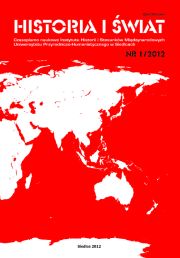Datacja reliefów Szapura I. Zarys problematyki
DOI:
https://doi.org/10.34739/his.2012.01.01Keywords:
Iran, Sasanian, Sasanian art, rock reliefs, Shapur I, Roman emperorAbstract
It is assumed that eight Sasanid reliefs were carved during the reign of Shapur I in 242 – 272. There is no doubt that seven of them: NRb I, NRb IV, NRm VI, VŠ I, VŠ II, VŠ III as well as that one from Rag-i Bibi depict the ruler. Identifi cation of the king in relief from Darabgerd is subject of further disputes. What enforces dating reliefs at Naqsh-i Rajab to 242 – 244 is lack of portrayals of enemies defeated by Shapur. Starting point for more precise dating of socalled triumph reliefs is identifi cation of persons appearing in them. There is no doubt about the relief at Naqsh-i Rustam. On the basis of ŠKZ text one ought to assume that it shows Philip the Arab and Valerian thus it should be dated to 260 – 272. The problem is over dating of reliefs at Bishapur. Damages of VŠ I relief allow only identifi cation of Philip the Arab and Gordian III that is why dating can be precised to solely 244-272. Lively discussion elicit another two reliefs of Shapur I at Bishapur . One of the most interesting hypotheses seems to be thesis advanced by B. Overlaet that Uranius Antoninus is the fi gure standing next to the king. Recognision of black stone of Emesa in VŠ III relief maintains the thesis. As far as stone identifi cation seems to be sure one should deliberate if Shapur I would place in the relief a person recognized by him as not equal to himself. It is unlikely from propaganda viewpoint. In that case we can refer to the king relation to Septimius Odenathus with whom he even did not start dialog. If we interpret the arrangement of relief we have to point that its composition refers to sculptures from Apadana in Persepolis. In the context of military activities and devastations of Syria by Persian forces one should not be astonished at symbolic representation of bringing gifts Syrians. For late dating of triumph reliefs indicates their asymmetrical composition which is untypical in case of Persian sculptures. One should recognize that they could be carved by Roman craftmen deported by Shapur I during wars with western neighbour. Anyway it does not help in more precise dating because fi rst deportation took place already in 253. Taking Valerian as prisoner seems to be the most important success of Shapur I. The emperor undoubtly was residing at Bishapur so in a natural way he was put in both VŠ II and VŠ III reliefs what allows their dating to 260-272. The above mentioned speculations do not make easier dating of the most controversial relief from Darabgerd what will be undoubtly subject of future disputes.
Downloads
Downloads
Published
Issue
Section
License
Copyright (c) 2012 Historia i Świat

This work is licensed under a Creative Commons Attribution-NoDerivatives 4.0 International License.




